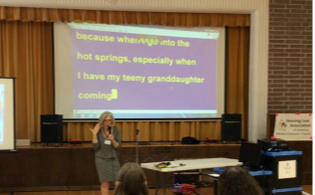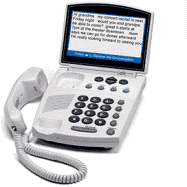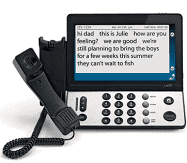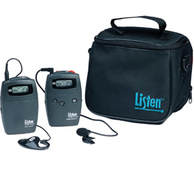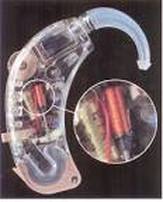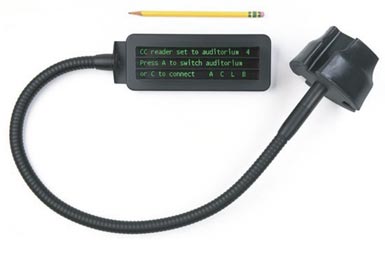Open Captioned (OC) Movie Bill -
a Civil Rights Issue
a Civil Rights Issue
Typical signage for Movies that are Open Captioned
Have you been to a movie with open captions yet?
Movie captions are nothing like what you see on TV. Movie captions do not scroll, and are perfectly synchronized with speech at the bottom of the screen, and are in easily readable segments! Open captions finally make movie dialog accessible for people with hearing loss. See what you've been missing! Thoroughly enjoy movie-going again! - Pauline and Vickie
For all the details, click here
Colorado Movie Theaters Offer Open Caption Movies!
What are open captions?
Open captions are the stationary on-screen captions of the spoken word in films
Click here for theater schedules
What are open captions?
Open captions are the stationary on-screen captions of the spoken word in films
Click here for theater schedules

So, You and Your Hearing Loss are Going to the Hospital...
- Guide for Effective Communication for Patients and Providers - The guide was created for patients, companions, all members of the health care team, administrators and support staff. It provides information, resources and tools to help improve communication in medical settings. It helps hospitals, facilities and private offices follow federal, state and local laws, regulations and health care standards, and allow patients to ask for and receive the services that ensure safe and effective communication. Read more here.
- HLAA Communication Access in Health Care - HLAA's program embraces a diverse group of stakeholders invested in the delivery of health care: providers, medical systems, public health researchers and patients.Together, we collaborate toward the common goal of effective communication for people with hearing loss and their companions in all medical encounters. Read more here
Colorado Movie Theaters Now Offer Open Caption Movies! Click here for schedules.
Hearing Accessibility for people with hearing loss can include captioned text, **hearing loop technology, and assistive listening technology devices.
Learn about technology beyond hearing aids that will
enhance your ability to hear in a variety of challenging listening situations
enhance your ability to hear in a variety of challenging listening situations
** To learn more about Hearing Loop technology, click on the page: "Get in the Hearing Loop"
Smartphone Speech-to-Text Apps
Some popular apps are listed below. Some are for Android and/or iPhones;
Most are free, but some charge a fee
Ava
Otter
Google Live Transcribe
TextHear
Some popular apps are listed below. Some are for Android and/or iPhones;
Most are free, but some charge a fee
Ava
Otter
Google Live Transcribe
TextHear
CART (Communication Access Real-Time Translation
CART is the verbatim, near instantaneous conversion of spoken language into text.
|
CART captioning can be provided
|
Captioned Phones
Captioned Phones show written captions of everything the caller says
|
The written text appears in a built-in display screen. Captioned phones and service are provided at no cost.
Captioning can be provided on landlines through Telephone Relay Service (TRS). Or, if you have internet service, you can even keep the same phone number you already have. Click on one of the vendors below for more information. T-CoilsIf you have a tele-coil (t-coil) in your hearing aid or cochlear implant, you can take advantage of its direct-audio-input feature to hear on a landline or cell phone, while cancelling out the background noise.
Assistive Listening Devices (ALDs)An ALD increases the loudness of a desired sound (e.g., a radio or television, a public speaker, an actor, someone talking in a noisy place) without increasing the loudness of the background noises.
Sophisticated systems are used in theaters and auditoriums. Scroll down for a list of venues with ALD systems. Personal ALDs can be purchased (scroll down for the ADCO catalog). For more information on Hearing Assistive Technology, click here. To learn more about each specific technology, click on each video topic below - the series is captioned.
|
Smartphones and Hearing LossSome smartphones have built-in technology and that helps you hear in one-on-one situations. Check for these features for you specific phone.
And, when shopping for a cell phone, be sure you get a phone rating of M3/T3, or M4/T4, which will ensure hearing aid compatibility without interference. You can also receive free real-time captioning on your cell phone with the free App from InnoCaption - Read more, and watch this video
Voice-to-Text voicemail is available on some cell phone providers (check with your provider). The telecoil can make a noticeable difference in your life when combined with hearing assistive technology. This pairing of technology bridges the space between you and the sound source while most of the background noise is eliminated.
Have you ever had difficulty hearing or understanding:
In those situations, an assistive listening device can help. Hearing aids provide all-purpose amplification, but, oftentimes an assistive listening device (ALD) can enhance the listening experience in a challenging listening event. Captioned ALDsMovie theaters Devices
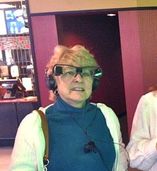 Sony Caption Glasses and.ALD Combo Sony Caption Glasses and.ALD Combo
Sony captioned glasses are worn just like regular glasses, and the captions are displayed on the lenses (these can be worn over your own) 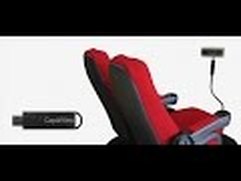
Captiview devices fit into your seat cup, and captions are shown on its screen |
For information on Hearing Loop Technololgy, and for a listing of venues that have professionally-installed loops, click on the tab, "Get in the Hearing Loop"
The Americans with Disabilities Act (ADA) is about enabling people with disabilities to take charge of their lives and join the American mainstream by facilitating public access, accommodations, and the use of communications systems. The ADA upholds the principle that each individual has the potential, and deserves the right to participate in, and contribute to, society.
Legislation has been passed to enhance accessibility to public places, work places, schools, government and businesses for people with hearing loss.
HLAA, together with other consumer and professional organizations, works not only to pass legislation to improve the quality of life of people with hearing loss but also to push for implementation and strong enforcement of the laws.
Rocky Mountain ADA Center (ADA-Americans with Disability Act) Rights of Deaf and Hard of Hearing People to Accessible Communication. Title III of the Americans with Disabilities Act (ADA) gives rights of equal access to places of public accommodation. For deaf and hard of hearing people, Title III requires businesses and agencies to remove barriers to communication.
Legislation has been passed to enhance accessibility to public places, work places, schools, government and businesses for people with hearing loss.
HLAA, together with other consumer and professional organizations, works not only to pass legislation to improve the quality of life of people with hearing loss but also to push for implementation and strong enforcement of the laws.
Rocky Mountain ADA Center (ADA-Americans with Disability Act) Rights of Deaf and Hard of Hearing People to Accessible Communication. Title III of the Americans with Disabilities Act (ADA) gives rights of equal access to places of public accommodation. For deaf and hard of hearing people, Title III requires businesses and agencies to remove barriers to communication.

